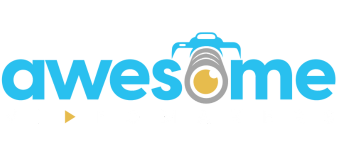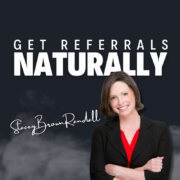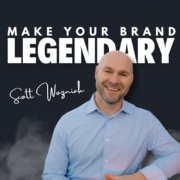151. How to get referrals without asking with Stacey Brown Randall
Want to learn a really simple, really effective process to build a referral network & generate a ton of referrals so that you’re getting a steady stream of right fit clients? — without manipulating, offering incentives, or even having to ask?
Because, honestly, asking for referrals can feel pretty darn awkward…
Which is why I’ve invited this week’s guest Stacey Brown Randall on to talk about her step-by-step process that not only identifies potential referral sources but also encourages them to bring you more and more business
And here’s the cool part – you don’t even have to ask!!
Listen up because this interview completely changed how I think about referrals
Stacey’s the author of “Generating Business Referrals Without Asking” and she’s the host of the Roadmap to Referrals podcast.
Resources
I help B2B business leaders, consultants & coaches create a short-form video sales system that makes selling easy.
In a 1-hour remote interview you get 1 month of short form video content that does your selling for you.
Imagine having dream clients excited to buy from you because they’ve been pre-sold by your videos.
Transcript
Stacey Brown-Randall:
Most people think referral sources have to know I’m amazing before they’re ultimately going to refer someone to me and it’s kind of shocking to find out that’s not really the case. They have to know what you do, but the trust factor they have in you is this baseline of like yeah, brad does great work until Brad proves me different. Right, until he proves me wrong, we all assume other business owners do great work until we learn otherwise. So people feel like I got to train my referral source to know what I do and who’s my ideal client, and I’m always like drop that word train from your vocabulary. Your referral sources are not docs. They do not need to be trained. Really, what it looks like is that trust in you has to do with the relationship. It has to do with the fact that when they have someone that has a problem, you’re the name that pops into their head.
Brad Powell:
Welcome to the Standout Business Show, where it’s all about making a bigger difference by doing business differently. I’m Brad Powell, and here’s my challenge for today’s episode. And here’s my challenge for today’s episode how would you like to learn a really simple, really effective process to build a referral network so that you’re getting a steady stream of exactly right fit clients? And this is without manipulating, without offering incentives or even having to ask incentives, or even having to ask, you know, because, honestly, asking for referrals can seem pretty darn awkward. All of this is why I’ve invited today’s guest, stacey Brown-Randall, onto the show, because she’s developed a step-by-step process that will not only identify potential referral sources, but will also encourage them to bring you more and more business. And this is the cool part you don’t even have to ask. So are you intrigued? Do you want to know how this works? Stacey’s the author of Generating Business Referrals Without Asking, and she’s also the host of the Roadmap to Referrals podcast. So, with all of that, stay tuned and let’s start the show. All right, stacey, welcome to the show.
Stacey Brown-Randall:
Thanks so much for having me. I’m excited to be here.
Brad Powell:
Yeah, me too, because everyone knows at least they should know that getting a good referral is probably one of the best things to happen for your business. Some of my very best clients have come from referrals, and the ones that have really fit in and lasted the longest and we’ve had this wonderful relationship have been from referrals. And the ones that have really fit in and lasted the longest and we’ve had this wonderful relationship have been from referrals. They just seem like the very best kind of person because they’ve come to me from somebody who knows me already really well and they know who would be a good fit.
Brad Powell:
The problem is that it’s hard. How do I get referrals that’ll come on a regular basis? How do I get referrals so that there’s a regular basis? How do I get referrals so that there’s not like one in January and then not another one until September? And so when people think about referrals, let’s just start right here. What are the misconceptions and sort of the way they’re looking at it? That’s the mistake. The way that they’re trying to get referrals or thinking about it. That’s just not right.
Stacey Brown-Randall:
Thinking mistake that the way that they’re trying to get referrals or thinking about it. That’s just not right thinking, oh, brad, there are so many, there are so many misconceptions out there, and it’s you know, I think when you think about referrals it’s this holy grail right of how to generate new clients, which means everybody kind of wants a piece of the action, like business owners want to be able to receive them and other people want to be able to teach how you’re supposed to go about generating those referrals. And there has been a consistent like drumbeat that has been beaten about how to get referrals for decades and decades, I would say even generations, and it’s really been. This whole idea of what you talked about in your opening is that you have to ask for them, and so that’s the first big misconception. It’s one of those things where it’s like been around for so long, everyone takes it as fact and except for the fact that it doesn’t really work and it’s awkward and uncomfortable and people don’t like it and the majority of people won’t do it. So the first big misconception I always find that people have is how they think they’re supposed to go about receiving those referrals. But that’s surface level for me.
Stacey Brown-Randall:
I mean, I’ve been doing this almost 11 years now teaching people how to generate referrals, naturally, and for me, that misconception of like oh, how you think you’re supposed to get them, ask for them or incentivize for them or network all the time to always be seen and remembered, be gimmicky and promotional, that’s surface level misconceptions for me. I think it also goes one layer even deeper and even probably more than one layer deeper. Then it’s like it’s down to like how we define a referral, understanding the science behind referrals, like what’s actually happening in the brain of your referral source when they are making the decision to refer to you, right? And so it’s understanding the ecosystem of where referrals are actually hanging out in your business. So there’s a lot of different misconceptions that people have about referrals and, to your point, the first one I always have to get past is this whole concept of no, you shouldn’t ask for referrals.
Stacey Brown-Randall:
There are lots of people out there who can teach you how to ask. I’m going to say don’t you dare ask, because it violates the science and it’s actually going to hamstring your ability to generate ongoing, consistent referrals, which is what we ultimately all want, right? And so it’s the. It’s the misconceptions around how we think we’re supposed to go about getting them, how we’re supposed to get them, and then there’s another layer, deeper of that, with the misconceptions that are really about like what that looks like in your business and understanding the definition and making sure you understand the science behind referrals as well. So there is a lot of misconceptions.
Brad Powell:
Right, all right. Well, the thing that sparked my interest from what you just said is what’s really going on in people’s brains when they refer you. I mean that’s super interesting and so, yeah, the psychology of that, I think, is probably the key. We want to know. It’s very similar to when you’re thinking about your audience or your customers or your prospective clients. You want to know what’s going on in their minds when they’re actually taking that step to buy your offer or come and hire you for your service. It’s the same kind of knowledge and connection we want to make with a potential referral partner, like, well, what’s going on for them, or what would be going on for them that would make them respond spontaneously and be feeling like this is a really good idea to refer this person. So what is going on there?
Stacey Brown-Randall:
Yeah, so the piece of science that everybody understands and everybody gets is the psychology of trust. Right, that’s the piece I feel like I was like oh right, when a prospect is referred to me, they show up already trusting me right From that perspective, because they trust the referral source, the person who referred them to me, and that trust is transferred right. So almost everybody understands that you’re the prospect’s going to trust you because they’re going to take that trust right from the referral source who trust you. So it’s important from a science perspective that your referral source trusts you. But that’s usually the like, that’s it, like, that’s what people get when it comes to the science of understanding how referrals work, and when you think about it from that perspective, right, it’s just based on what the referral source right, that they have trust in you. That then brings up a whole bunch of tactics that people are taught about how to maintain that trust, and it’s looking at it all backwards. So the first thing, right before we even get to the psychology of trust, the first thing is what, exactly what you said, what is going on in the brain of that referral source when they’re making the decision to refer you? Here’s the thing they’re not first thinking about referring you.
Stacey Brown-Randall:
What they’re doing is having a conversation with someone who has a problem. Right, they have a problem, they have an issue, they need to solve it. Whether that is your neighbor that needs to sell their house, or a business colleague who really needs a new CPA, they have a problem. And so let’s say, for example, that I’m the referral source, right, and I’ll use you and I in this scenario. So when I’m having a conversation, let’s say, with my friend Sarah, and she really needs help, I’m having a conversation with her and in the moment that we are having that conversation, you’re not in my brain, right, you’re not there yet. Like, you don’t exist yet. You will get there, don’t worry, but you don’t start there.
Stacey Brown-Randall:
Where it starts is I’m having a conversation with Sarah and Sarah’s like I have this problem and I need this help. And I’m like oh, great, let me help you. Oh, and I know exactly how to help you, I’m going to refer you to Brad. And so you’re the secondary piece to the referral happening. And so when I’m having a conversation with Sarah and she says I need help, there is a happiness.
Stacey Brown-Randall:
Trifecta, that’s what the scientists call it, that’s not what I named it. There’s a happiness trifecta that happens in our brain when the chemicals are released, the feel good chemicals. When we’re doing something that feels good and helping someone else releases those chemicals right. And so when we are in that moment of happiness trifecta, we feel like the hero, like we’re doing something good to help someone and we feel good about doing it. And then the byproduct of that is that and how I’m going to help you solve this problem is by referring you to Brad, and that’s when you enter the equation and not before.
Stacey Brown-Randall:
So you can see that if a real referral is going to show up and it is going to be somebody who knows they have a problem, is willing to spend money to solve it, is willing to be connected to you to talk about possibly giving you their money to solve it. You know that there has to be connected to you to talk about, you know, possibly giving you their money to solve it. You know that there has to be that need identified and that’s a real referral. And so, from that perspective, right, if in the moment of happiness trifecta happening, you’re the secondary piece, you’re just the solution provider, you’re important and you’re necessary, but you’re not most important. Most important is that referral source, so you can see when the strategy people are taught or the tactics people are taught will just offer to pay for those referrals. Just offer to pay or just offer to ask, right, you’re then asking me to create something that has not been created. You’re asking me to manufacture a situation where someone needs you, or to artificially create someone who may need your help. And that’s not how a referral starts. Not the right ones that show up that are less price sensitive, ready to hire you. They’re like Brad, just take my money, right. Those are very special kind of referrals and that’s the one we want, and we want plentiful of them, right, we want as many of those as we can get. But we have to recognize that in that process, in that moment, what’s going on in the brain is I’m being the hero, and how I’m going to be the hero and solve the problem is to refer them to you, and so you have to keep the referral source as the hero in mind. Then, of course, I’m only picking you to refer to because I trust you, but how I trust you is actually on the relationship we have.
Stacey Brown-Randall:
Most people think referral sources have to know I’m amazing before they’re ultimately going to refer someone to me and it’s kind of shocking to find out that’s not really the case. They have to know what you do right. I can’t refer you to do someone’s taxes when clearly that’s not what you do right. So they have to know what you do. But the trust factor they have in you is this baseline of like yeah, brad does great work until Brad proves me different. Right, until he proves me wrong, we all assume other business owners do great work until we learn otherwise. So people feel like I got to train my referral source to know what I do and who’s my ideal client, and I’m always like drop that word train from your vocabulary. Your referral sources are not dogs, they’re not pets, they do not need to be trained Right.
Stacey Brown-Randall:
And so it’s understanding that really, what it looks like is that trust in you has to do with the relationship.
Stacey Brown-Randall:
It has to do with the fact that when they have someone that has a problem, you’re the name that pops into their head and that’s really important and that’s based on the relationship you have and it is built around the psychology of trust.
Stacey Brown-Randall:
But it’s also built around the dynamics of social networks and other things that are actually at play and just the willing, the, the you being memorable right Because they actually remember you in the moment. So there’s some other things that come into play from that perspective, and so those are the things I think people overlook when they’re trying to figure out how to make referrals happen is when you ask or offer to pay or feel like you have to always be seen to be remembered right or you’ve got to be overly gimmicky or promotional, you’re violating that science of what actually needs to in some cases occur naturally. And then, of course, you need to make sure you have the right relationship with your referral source so you are top of mind when those opportunities present themselves, which means who refers you is important, because not everybody will and you’re not supposed to have relationships with everybody. You’re supposed to be very strategic about who you form referral source relationships with or who you try to cultivate as a referral source so that there is opportunity to refer to you.
Brad Powell:
Yeah, well, I really. It’s so interesting how parallel this is with the same approach to seeking new clients, in that the basic trope is you want to make your customer the hero of whatever communication that you’re going. It is not you, it’s not your product, it’s not your thing. It’s really all about them and their stuff. And in this case, you’re transferring that I love the term happiness, trifecta. You’re transferring that onto this person who’s helping themselves, because they’re going to feel good when they’re helping someone else. It’s just human nature. We’re so terrific. Actually it doesn’t matter who it is.
Brad Powell:
If you have an opportunity to help someone. This could be like you know any stranger on the street who comes up to you and says, hey, I’m lost, can you help me find whatever? Like there’s not a single person who’s not going to go. Ok, fine, here let me tell you all this stuff. You know we’re just generally normally helpful creatures and so when we get to do that for someone who we actually like and care for, so much the better. And if you, by being the referral partner, are part of that solution, if you’re part of that story, great, terrific. You’re helping both your friend who’s the referral partner, and as well as the potential client who’s doing that. That’s so great, all right. So if I’m not asking and I’m not going to networking events all the time and I’m not worried about being seen and heard by whatever group of people, what am I doing? Like if someone’s saying, okay, I want to get started with being able to build relationships that will bring referrals? What are the first steps that people should be doing?
Stacey Brown-Randall:
Yeah, I’d like to teach this from the perspective of it’s. There’s some foundational strategies you need in place in your business and we worry about those first before we move into situational strategies and then moving into next level strategies. So that’s kind of how I like to teach it. I think it gives people a way to like group things in their minds, which I think is easier to think about. Okay, what do I do first? And that’s just the foundational things that we need to have in place first. And so I always tell folks there are three main places where you want to focus on being able to generate referrals. This is not the only places, this is not the only thing we will do, but these are three foundational places, and one of them is based on who’s already referred you, who’s referred you in the past. Either maybe they’re currently referring you, meaning they’ve referred you this year, or they’ve referred you in the last couple of years. Those we refer to as your existing referral sources. And just let me just say a referral source is always a human. You don’t get referred from a networking event. There’s somebody at that networking event that refers someone to you, right? So it’s always a human first and last name. So when we think about our existing referral sources, it means just that they’ve referred you in the past. It could have been two days ago, it could have been two years ago.
Stacey Brown-Randall:
When we dig in deeper to understanding our referral sources, we look at things like types and statuses and things like that, but at a basic level it’s understanding. Do you have people who have referred you before? Because that is ultimately when I’m working with someone. That’s where I want to start, if I can, because it’s their low-hanging fruit Someone who’s actually already referred you. It is easier to get them to continue to refer you and to refer you more with some right strategies and tactics. If we have that, not every business is going to show up that’s going to ultimately have existing referral sources. But if you’ve been in business more than a couple of years, more than likely you have people who have referred you or tried to refer you in the past. This doesn’t mean they referred you someone who gave you money. It could be they referred you someone as a prospect, but the prospect didn’t say yes, for whatever reason.
Stacey Brown-Randall:
We still want to make sure we’re capturing the names of those referral sources. So that’s the first foundation is existing referral sources, people who have referred you, knowing who they are and then having a strategy to ultimately get more referrals from them. The second piece is people that you wish would refer you, right? So if I’m having this conversation in my own head, I may be like, oh my gosh, brad knows so many people, it would be amazing if he would refer me, but he’s never done it. Well, the process you take somebody through to start referring you when it’s never crossed their mind to refer you looks very different than somebody who has referred you already.
Stacey Brown-Randall:
So we call these our potential referral sources, or sometimes, with my clients, I call them soon to be referral sources. They won’t. Even though we identify them, that doesn’t mean they’ll all turn into future. You know they will all be a referral source in the future, but those are potential referral sources. They’re the people that you wish were referring you and they’re going to probably be made up of your clients, if that’s possible, and centers of influence. And so we want and so say with your existing referral sources too.
Stacey Brown-Randall:
But when you think about those potential referral sources, these are people you want to refer you but haven’t done it yet, and there’s a different strategy we follow to actually cultivate them to the place and build a relationship with them, to the place where they get to the point where they will refer you. And it’s very backwards and it’s both. Most people are like wait, I don’t actually talk about referrals. I’m like you better not yeah, it’s bad Like you’re going to focus on them and the relationship that they have with you. And so that’s our second, which is potential referral sources. And then there’s a third strategy and I very rarely start a client with this strategy. I try to do the first or the second, because that’s more like what we call hand to hand combat. It’s kind of like, hey, we’re going to identify people and we’re going to know exactly what we’re going to do to start being able to cultivate referrals or generate referrals from them.
Stacey Brown-Randall:
The third one is actually your referable client experience. So this is a process that you have within your business. So every business has a client experience, whether you’re intentional about it or not, your clients feel something while they go through the motions of working with you, and how they feel is ultimately defined as their client experience. Lots of people have really strong great. I provide great work, I do great work, my clients love me, but no one refers me and that’s because great work does not equal referrals. Like you actually have to have a client experience that is built around being referable and then knowing how to leverage those referral moments throughout your client experience to see if you can percolate it in someone’s mind to ultimately refer you as they’re working with you or when they’re done working with you in the alumni stage. And so the client experience is that third foundational piece. When we can have those pieces in place, we’re in a really good place to start generating more referrals. And then, of course, we look at the situational things right and then the next level things after that.
Brad Powell:
Yeah, that’s so great. I mean okay. So there’s three levels. Level one is who’s already referred you in the past, and then I’m going to call them dream referrals. Who are the people who are like absolute best possible case of someone you’d love to have be a referral partner who hasn’t done it yet. And then the third one is when you’re talking about client experience, are you talking about, like capturing the client experience as a way to showcase what happens with people? What exactly do you mean when you say the referral of referable client experience?
Stacey Brown-Randall:
Yeah, so, okay. So if you think about the work that you do with any of your clients, there is an experience that your clients go through. Right, most people define their client experience by the work that they do. You sign your letter of agreement, then you become a client, you pay your deposit and then right, and then we kind of move through and then we have our first meeting or a second meeting. I deliver, like, if I’m a web designer, right, then I deliver for you the website and you give me changes.
Stacey Brown-Randall:
Like most people think about the process of what their clients go through from a work perspective, but that is only one half of the equation of your overall client experience. Your client experience is how your clients feel while they are working with you, and that feeling continues when they’re done working with you as well. And to impact how your client feels, right, not only do you have to have a great work process right, and you have to have what we call those work touch points, but you also have to make sure you’re layering the right relationship touch points as well, and so the ability to have a referable client experience comes down to your clients being like wow, I just didn’t expect that from Brad, or this is unlike anything I’ve really ever experienced before and it’s not expensive and it’s not complicated. People overthink this stuff all the time, but it is being intentional about as your client is working with you. What are they feeling and how are you addressing that, not only in the work that you’re doing for them, but in the relationship you’re building for them as well. And to make this manageable for my clients, I break it down into three stages. It’s kind of like what is happening from a work perspective and a relationship perspective in the new stage, and then what’s happening from a work perspective and a relationship perspective in the new stage. And then what’s happening from a work perspective and a relationship perspective in the active stage. And then what’s happening in the work perspective, which usually there isn’t any at this stage, but what’s happening in the relationship stage when they move to an alumni client. Now, some people want to have their clients forever and they never want them to leave, so they never move into alumni. Their active becomes ongoing.
Stacey Brown-Randall:
But this idea of like their stages your clients go through and we want to make sure that not only are you delivering great work, but you actually have some factors in there that are really building that relationship and impacting how they feel about you. Because I may stay with you if you give me an average client experience, like, yeah, it’s fine, whatever it’s good, right, I may stay with you forever. Give me an average client experience like, yeah, it’s fine, whatever it’s good, right, I may stay with you forever because it’s a pain in the butt to go somewhere else, but that doesn’t mean I’ll ever refer someone else to you. And we want to make sure that that client experience it has that referable process within it as well and that starts from kind of like whoa, this was an amazing client experience. And it’s used in the words because it’s the feelings your clients have and then, knowing those moments, throughout those stages, that we can plant referral seeds to get our clients to start thinking about referring us.
Brad Powell:
Yeah, well, I just want to echo that. I mean, I think I know in my own experience, I would say most of the very best referrals that I’ve ever received have come from clients and usually while we’re still working together, you know, like we’re doing the thing they’re not done yet, like we’ve got an engagement and they’re in the middle of the process that we’ve decided to work on together and somewhere in there, without asking, without any kind of anything, all of a sudden they’re saying hey, you know, there’s this person, I want to introduce you. And next thing, I know I’m talking with that person and it turns out they’re a great fit and I start working with them. That seems to work extremely well without like, I just right in the mode of without even asking.
Stacey Brown-Randall:
And actually we refer to that as the right people been asking, and actually we refer to that as the right people. There are just some clients you are going to have the ultimate privilege to work with that because you were delivering this great client experience that their brains are going to be like oh, this is awesome. I got to connect Brad with this person and this person right, it happens to me all the time too. Now obviously I have some. That referable piece is behind my client experience as well, because I try to make it happen a little bit more often, right?
Stacey Brown-Randall:
But the idea is is we refer to that as right people in addition to the and you can’t say nobody walks into your client experience with a like a label across their head that says I’m, I’m going to refer you. Like, nobody shows up with like a label that says I’m going to be a great referral source for you if you do a great job, right, but there will be those people who are just the right people and they naturally think about referrals. The problem is, most of your clients aren’t going to be like that, and so then we also have to look for what we call if it’s not a right person. Right. We’re paying attention to that because they immediately go to your existing referral source list and now we have a way to take better care of them, because they referred you kind of like on their own right. And then we also look for hot zones. It’s the moments where people are more likely to refer you through that client experience and make sure that we’re leveraging that as well.
Brad Powell:
Yeah, right, okay. So I just want to go back to step one. Like I think the easiest first step for anyone, myself included, would be to actually look at, well, who has been a referral person in the past and what are the things that I or anyone could do to help nurture and continue that relationship, which would only encourage them to be thinking, yes, I want to be helpful. One of the ways that I can be helpful to the people that I know is to refer people to, in my case, brad, or to refer people to Stacey or whatever. Like what are the simple things that people could do? Like I think everyone can think of pretty quickly, easily, a handful of people who have referred them if they’ve been in business for any length of time, and so it’s like, okay, so I know these people, they’re in my Rolodex. Nobody has a Rolodex anymore, but they’re in my database and I can contact them and you know. So what anyway? What do recommend people do to to rekindle those kind of relationships?
Stacey Brown-Randall:
Yeah, first thing I want you to kind of keep in mind is is, when you have people who’ve referred you before, you’re not ever going to approach it as great how can I be helpful to Brad? These people are thinking how can I be helpful to Brad by referring him more people? No one’s thinking that. So I mean we all wish that everybody was thinking that like, oh, I woke up today and thought about how could I refer to Stacey? I would love it if people thought that every day Nobody wakes up and thinks that. So we kind of have to keep in mind that it’s not about them thinking about helping you. That doesn’t mean some people aren’t unicorns or kind of built that way. Most of us aren’t, though. It’s just the reality and a fact of life.
Stacey Brown-Randall:
So once you’ve identified who are your existing referral sources, then you need to pay attention to who’s active versus who’s inactive, because if they’re active, it means they referred you. And my definition we use the last two years. Some people choose to use within the last year, but it’s never longer than two years, and then inactives are more than two years ago. Well, your inactives. Before you do anything, they probably need an opportunity to just reconnect with you and that reconnection won’t be about referrals at all. It’ll just be about reconnecting right, because if they haven’t referred you in a couple of years, you probably have a relationship that needs to kind of probably be restarted possibly. And so we always talk about we re-engage the inactives differently than how we start off taking care of our active referral sources. And so, from that perspective, what I teach my clients is that you need a strategy or a plan where five, six or seven times throughout the year so this is not daily, weekly or monthly where you are going to do outreach to those existing referral sources. And there’s a formula that I teach it and it’s based on behavioral economics.
Stacey Brown-Randall:
But there’s a formula that I teach to my clients about how we pull together, what those five, six or seven outreaches, or what we call touch points, are ultimately going to be. And this is going to be something where the formula is based on the idea of you being memorable and meaningful. So your newsletter does not cut it, and a text message that says how are you doing Isn’t going to cut it either. Or anything you email isn’t going to cut it either. So it’s about being memorable and meaningful. It’s about, of course, being mindful of your budget and what that looks like. If you have five people or 55 people, it’s going to look a little different from a capacity perspective and then making sure that you are also using and this is kind of my secret sauce is the right language which we call referral seeds. So it’s doing those five, six or seven touch points. It’s making sure those touch points are memorable and meaningful and that looks different for every person, based on their personality and then also within their business and their industry as well. And then, of course, making sure that gives us that opportunity to plant the right type of referral seeds, and those change too, based on what outreach we’re doing.
Stacey Brown-Randall:
So once you’ve identified who your referral sources are, then look for their commonalities Like what do they have in common and then what you need to do is take the next step to build out a plan of how are you going to be top of mind with them in a memorable and meaningful way, which means what are you gonna do for those five, six or seven touch points?
Stacey Brown-Randall:
And for some folks, once you see the list of names, you’ll be like, oh, I know exactly what I want to do, and other times you look at that list of names, you’re like I have no idea. Then that, of course, that’s why I’m here to help, right? But the idea is is that you need a way to make sure that you are staying top of mind with them, but not in a way like everybody else. You can’t be more noise in their inbox. You actually have to be memorable and meaningful and you have to impact how they feel about you, which is wow, brad really cares, and that you have to spend some time thinking through what those touch points will look like for the person receiving. It will be like wow, brad really cares, and that’s the plan you want to build.
Brad Powell:
Yeah, I know that just naturally with people who are in my realm, I’ll hear something or I’ll see a book or I’ll listen to a podcast episode and it’ll make me think of a particular person. It’s like, oh, this is perfect for this person and I’ll just send it to them and say, hey, so here’s the thing about that.
Stacey Brown-Randall:
Those are great and I tell folks, those are what we call one-offs and you should do them when you think about them, hands down, but you don’t know when that’s going to happen.
Stacey Brown-Randall:
And so, in addition to the one-offs happening like that, like I listened to a podcast episode, I had to share it with this person, right and in addition to those one-offs happening, you have to have a plan in place where you know, at least five times a year there’ll be some outreach happening to those existing referral sources where you can impact how they feel and you can show that you care and that you’re thankful for their referrals. So that has to be built. And then the one-offs are like layered on top of that.
Brad Powell:
Yeah, that sounds really rich. That’s great, all right. Well, this is, this is terrific. I mean a lot of really helpful stuff here. And so now someone is thinking, okay, stacey, I’m in, like I want to. I want your help to set this up. What is the best way for them to connect with you?
Stacey Brown-Randall:
Yeah. So my website, staceybrownrandallcom, is going to have all the information you need. We have three ways that people can work with me. It’s all right there on the homepage. We try to make it really really easy. The easiest way for people usually to get started is with my starter course. It’s called your Next Five Referrals. This is really the things I wish people would have in place before they started working with me, either in my group coaching program or working one-on-one with me at my VIP level, so that next five referrals really helps you get all of the processes behind the scenes in place. That allows me to just move faster if those are already in place. So your next five referrals starter course is a great place, and then, of course, I have a coaching program and I have a done-for-you VIP option as well. But those are all listed on the homepage and if you’re not ready to dive into, let Me Just Go Work With Stacey.
Stacey Brown-Randall:
I have a podcast that drops a new episode every Tuesday. We’re over 300 episodes in. It’s called Roadmap to Referrals and my first book that is out is Generating Business Referrals. Without Asking. You can grab the Audible or the ebook or the printed copy of that book and then eventually, sometime next year, I’ll have a second book out as well, but there’s lots of places to go to dip your toes in before you decide. You actually maybe want to work with me.
Brad Powell:
Right, all right. Well, I’ll make sure that links to your website and your podcast are in the show notes. And congratulations on your second book.
Stacey Brown-Randall:
Well, that’s a little premature. I got to finish it first.
Brad Powell:
I mean it’s coming. Maybe we’ll have you back on once that comes out.
Stacey Brown-Randall:
That would be wonderful. I very much appreciate that. Thank you.
Brad Powell:
All right, well, thanks again. So much for coming on today, stacey. This has been terrific.
Stacey Brown-Randall:
Thanks for having me.









